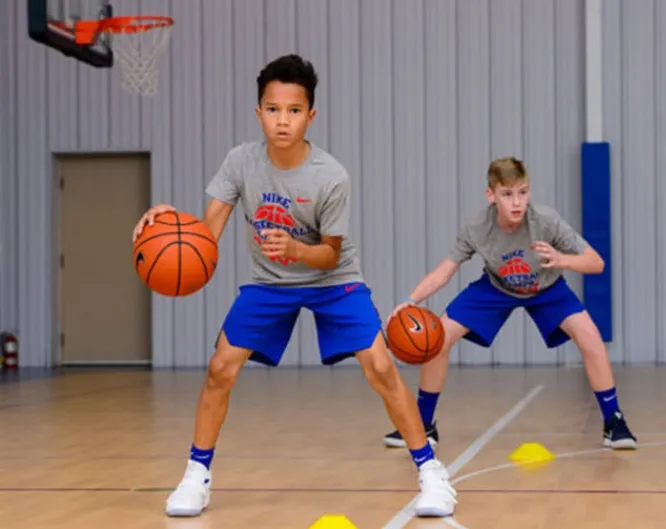Strong ball-handling is at the core of every great basketball player’s game. It’s not just about bouncing the ball—it’s about control, coordination, and confidence. Whether you’re running the offense, driving through traffic, or setting up teammates, the ability to handle the ball under pressure separates average players from great ones. In this article, we’ll explore what ball handling truly means and guide you through a series of progressive drills designed to help you master the craft.
What Ball Handling Really Means
Ball handling in basketball refers to a player’s ability to control the ball while dribbling, passing, and maneuvering around defenders. It requires precision, timing, and awareness. Elite ball handlers know how to change speed, direction, and rhythm seamlessly, creating space and scoring opportunities for themselves and their teammates. Guards rely heavily on this skill, but every position benefits from improved control and balance on the court.
Developing strong ball-handling skills involves mastering various dribbling techniques—crossovers, behind-the-back, spin moves, and between-the-legs dribbles—while maintaining full court vision. It’s a combination of muscle memory, quick thinking, and confidence built through repetition.
Twelve Drills to Build Ball-Handling Mastery
1. Stationary Dribbling
Start simple. Stand in place and dribble with one hand, focusing on control and rhythm. Keep your knees bent, back straight, and the ball low. Alternate between your left and right hand, then mix in basic moves like crossovers and between-the-legs dribbles. These stationary drills form the foundation for all advanced techniques.
2. Cone Navigation
Arrange cones or markers in a zigzag line. Dribble through them while maintaining balance and tight control of the ball. Focus on quick direction changes and using both hands equally. Gradually increase speed as your confidence grows.
3. Reaction Drills
Have a coach or teammate call out commands—“left,” “right,” “spin,” or “back.” React instantly, changing direction or executing the move. You can also use visual cues, like pointing cones or lights, to simulate real defensive reactions. This helps improve your ability to think and move quickly during live play.
4. Two-Ball Control
Dribbling two balls at once challenges your coordination and rhythm. Start by bouncing both at the same time, then alternate them. This drill strengthens both hands and builds confidence in handling the ball under pressure.
5. Full-Court Speed Work
Dribble up and down the court at varying speeds. Add defensive obstacles or markers to simulate game situations. Focus on maintaining control, keeping your head up, and making quick reads. This drill builds stamina and sharpens your transition game.
6. Mirror Challenge
Pair up with a partner and stand face-to-face. One player leads with dribble moves, while the other mirrors every motion. Switch roles regularly. This drill enhances reaction time, control, and your ability to read your opponent’s body movements.
7. The Dribble Gauntlet
Set up defenders—or use cones spaced closely together—and dribble through them using a variety of moves. Keep the ball secure and stay balanced as you weave through traffic. This drill trains you to stay composed while facing real defensive pressure.
8. Weak-Hand Focus
Spend dedicated time working only with your non-dominant hand. Practice basic dribbles, crossovers, and drives. Strengthening your weak hand eliminates predictability, making you more versatile and harder to defend.
9. Creative Dribble Tag
Play a fun, competitive game of dribble tag with specific restrictions—like using only your weak hand or performing a crossover before tagging someone. It’s an entertaining way to sharpen control, awareness, and creativity.
10. Combo Moves
Combine multiple dribble moves into one fluid sequence. For instance, perform a crossover followed by a hesitation, then finish with a spin move. As you improve, create your own combinations. This drill helps you develop rhythm, flow, and creativity under real-game conditions.
11. Change of Direction Drills
Set up cones in a straight line. As you approach each cone, execute a quick directional move—like a crossover, behind-the-back, or between-the-legs dribble—then burst forward. Focus on explosiveness and sharp transitions to mimic driving past defenders.
12. Defensive Pressure Practice
Have a teammate apply light defensive pressure while you dribble. Work on using hesitations, body fakes, and change-of-pace moves to keep control and create space. Practicing under realistic conditions builds confidence and poise in tight situations.
Frequently Asked Questions
Why is ball handling such a critical skill?
It allows players to maintain possession, create scoring chances, and effectively navigate through defenses. Without solid ball-handling fundamentals, players struggle to control the game’s pace and flow.
What are the core principles of good ball handling?
Keep the ball low, use your fingertips (not your palm), maintain proper stance, and always keep your head up. The best players dribble instinctively while staying fully aware of their surroundings.
Should I train one hand more than the other?
No. While it’s natural to favor your dominant hand, training both equally builds balance and unpredictability. Being ambidextrous makes you far more effective against defenders.
What mistakes should I avoid while dribbling?
Avoid dribbling too high, looking down at the ball, or over-dribbling when passing might be the better option. You should also stay composed—forcing moves often leads to turnovers.
Final Thoughts
Mastering ball handling takes time, patience, and consistency. These progressive drills are designed to build control, speed, and confidence from the ground up. Whether you’re a guard breaking down defenses or a forward driving to the rim, improving your dribbling will elevate every part of your game. With focused practice, you’ll not only handle the ball—you’ll command it.












